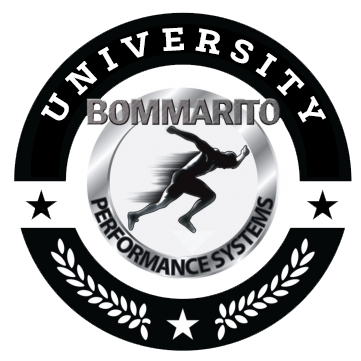Most athletes, sooner or later, will need to prepare for various measures of athletic performance tests such as the 40 yard dash, 3-cone drill, 5-10-5 shuttle, vertical jump, and broad jump. As strength and conditioning specialist its important to have an appropriate, effective, and efficient deigned strength program that will enhance athletic performance. For example, training collegiate athlete transitioning from NCAA football into the NFL, requires athletes to perform at their highest genetic potential. Below are the first 4 weeks of the BPS Elite Football Combine Prep periodization.
First, is the General Preparatory Phase (GPP). This first week involves performing pre tests for 3 of the athletic performance tests (225 bench press, vertical jump, and broad jump). This helps to gauge any imbalances each athlete has so a tailored strength program can be utilized. Once this is complete the athlete begins the strength progressions. In this week, the goal is to quickly realign the body bilaterally through the use of single arm and single leg exercises, neural adaptation, and hypertrophy. Also, this phase involves adapting the muscle tissue with volume in preparation for more aggressive high speed power. 
As we progress to the next week of strength training called the intensification phase, we put an emphasis on increasing the intensity of training, as the phase name describes. The concept of variable resistance is introduced to increase to further increase neural adaption by recruiting more motor units within the target muscles. More volume is added for increased hypertrophy and strength. Variable resistance such as bands and/or chains will increase strength for more of the muscles range of motion and as the bodies mechanical advantage increases.

In the third week of training, the athlete will move to the conjugate phase of strength training. The goal of this phase is to progress from hypertrophy and strength training into the power phase. This can be accomplished with more variable resistance along with faster tempos during the exercises. The first week of conjugate training is considered more strength than power training.
The concept of the Conjugate phase is to have one day of upper in the Strength and Max Strength levels; and the other day of upper in the Speed-Strength and Power Levels. The same concepts will follow for the lower body – one day SL Strength and Max Strength with the other day being Speed-Strength and Power. Note a lot of the Speed-Strength and Power is with the use of variable loading on multi-joint lifts of bench and squat, which emphasizes acceleration through the end range of motion.

Progressing to the second phase of conjugate training overloads the strength and power built in phase 1 of conjugate. More volume is added and more variable loading is added.

After week 4 of draft prep training, most athletes will be due for a downloaded lift in the weightroom. With this basic download lift week, the focus is to bring the volume down for upper and lower body days. Depending on the athlete, downloading the lower body and uploading the upper body may be appropriate. During this time of the year athletes will be invited to play in collegiate bowl games. If an athlete attends this week-long game he will not lift for that week and therefore, that counts as his download week. The low volume and/or no lift, allows the body to actively recover from the previous weeks of conjugate dynamic. Upon completion of this week, the athlete will be ready to increase the strength plateau by advancing into the next strength/power and power/strength phases.

The strength/power phase focuses on a big increase in intensity with emphasis on strength slightly more than power development. The first upper body day 1, with “clusters,” increases pressing strength dramatically. Pulling and elbow extensor volume is increase for more upper body strength, power, and endurance. The lower body days are designed to potentiate power output. Many resisted jumps paired with free jumps are effective in this phase. This jumping power will also transfer to the sprint training, which is preparing the athletes to peak in a few weeks.

The following power/strength phase focuses more on power output than strength gains. The previous weeks have prepared the muscles for massive gains in hypertrophy and strength, leading the athlete to peak performance for maximum power. Upper body days emphasize pushing power and realizing new plateaus for the 225lb bench press rep test. The lower body resisted jumps and clean pulls are light to focus on potentiating power through faster movements. Then, realizing the new plateaus for the broad and vertical jumps.

The final strength phase is the max/taper phase, which focuses on upper max strength through heavy weight with a power component by adding chains. Most of the pushing is fast and pulls are reflexive. The inverted row holds are designed to isometrically strengthen the muscles that are contracted at the bottom of the bench. This isometric strength will produce a more powerful stretch reflex on a 225lb bench press rep test. The 225lb bench holds are designed to isometrically strengthen the muscles involved in keeping the bench press body position base and elbow extensors that are keeping the arms straight. This strength will allow the athlete to have a temporary regrouping moment to make sure the body is properly positioned to perform single repetitions under fatigue during the end of an actual 225lb bench press test.



What is the Glute MAT exercise?
This is lying on your stomach in the prone position. Lift one leg (into slight hip extension) about an inch off the ground; contract the Glute for about 6 seconds; then release and repeat. Usually 6×6 sec holds. This isometric stimulates the Glutes to contract neurologically, which assists with the primary lift it is being supersetted with